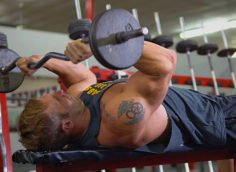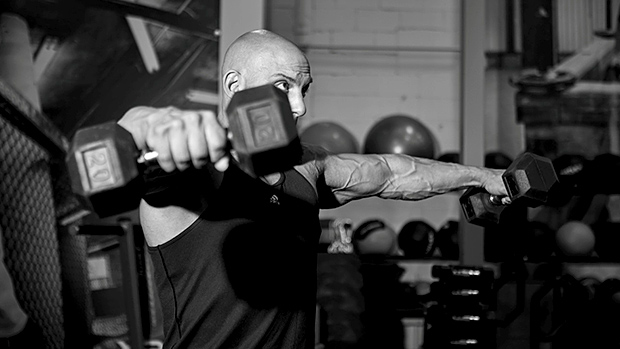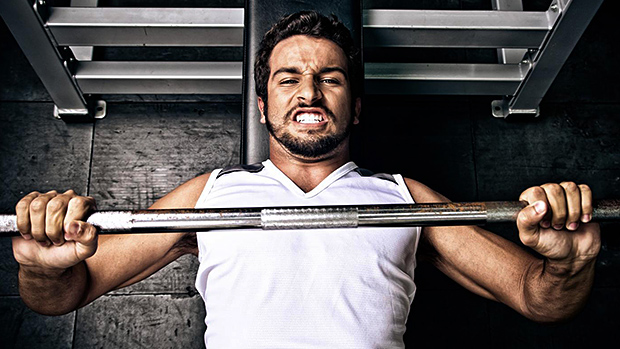How would you like to be able to ask some of the world's top bodybuilding and nutrition experts any question you wanted? Well, some of these guys charge hundreds of dollars for short phone or e-mail consultations, so you'd better have your checkbook ready. (Rumor has it that Ian King and Charles Poliquin charge $50 just for the privilege of fondling their sweat socks!)
Lucky for you, you don't have to fork out the green if you read T-mag. That's because every week we feature articles by the best minds in the biz. Now we're taking that one step further. As part of the new T-Forum, we've recently launched a special guest section. About once per month, the Guest Forum will feature one T-mag contributor who, for a whole week, will answer any question you throw at him – for free.
Our most recent guest was Charles Staley, one of the most respected performance enhancement specialists on the planet. He's earned his reputation from more than 22 years working "in the trenches" with everyone from everyday folks to Olympic athletes. We like Charles for his uncanny ability to cut through the puffery of weight training theory with razor sharp common sense and practicality.
Here's a few of the Q and A's from Staley's guest spot.
The "Rules" of Stretching
Q: Where do you place a flexibility session relative to a weightlifting or aerobic session? I usually don't have the energy for doing it straight after workouts so I stretch at another time. Is that okay? Since flexibility is a high priority for me, does that change the timing? Is stretching immediately after the workout good for recovery or can I stick to the cold shower?
GluteSpanker
A: Okay, a few thoughts on flexibility that should help to answer your questions:
1) Use various methods (static, dynamic, etc.) rather than seeking the "optimal" stretching method.
2) Shorter, more frequent stretching bouts are better than longer, less frequent ones. If you stretch for an hour a day, your body has twenty-three hours to tighten back up again!
3) When resistance training, stretch muscles between sets that you trained during the last resistance training session. Why? Because that's most likely when they're at their tightest.
4) Focus your stretching on the tightest muscles.
5) If you hate stretching (as I do) try to find a yoga or stretching class. Once you're there, you have no choice!
6) Don't get too anal about pre-stretch warm-up, especially if it prevents you from even doing it in the first place (due to time and/or energy constraints).
Hope that helps!
More Strength, Less Mass
Q: Charles, what are your recommended loading and frequency parameters for increased strength and power without any mass gains?
CoolColJ
A: Let's apply some basic logic to the question, shall we? Okay, for hypertrophy, you need to perform a lot of mechanical work, or volume. For maximal strength and power, you need to expose your neuromuscular system to strong tensions. So, if your goal is to improve strength without gaining weight, then you need to create strong tensions without doing a lot of mechanical work.
As a general guideline, I recommend low reps (1-3) and multiple sets (5-30) using big weights. Another option is to use mostly moderate weights while going through the concentric (lifting) phase as fast as possible. Minimize the eccentric (negative) emphasis and minimize or ignore muscle groups that are already strong enough. Additionally, isometric training is very useful because (you guessed it) you can create very great tensions without actually doing "work."
Balance Training
Q: I'd like your thoughts on balance training for sports. What do you recommend?
S-man
A: In my opinion, most of what's passed off as "functional training" today is really the unskilled and inappropriate application of rehabilitation protocols on healthy people.
Less Rest for Average Guys
Q: What tricks can you give us to improve in lifts like the squat and bench press?
Philtwine
A: Okay, maybe no tricks, but some food for thought:
1) A lot of lifters will benefit from resting less between sets during speed-strength and maximal strength training. Here's why:
• Most people, by very definition, with respect to nervous system proficiency, fiber type ratio, etc., are average!
• Also, you neither can nor should try to obtain complete recovery between sets. This is because you're negotiating a subtle tradeoff between conflicting demands, namely, you do need to recover, but the longer you recover, your CNS activation drops significantly. For example, if you do a max single and rest one hour, you'll get a nearly complete recovery, but your CNS activation falls right off the map, leaving you unprepared for the following set. Obvious enough.
• Maybe not so obvious: if you're average (and you probably are): A) you don't need the rest, because when you max out, you're only accessing a relatively small percentage of your capabilities as compared to a more talented lifter. B) You do need the activation! Even more than talented lifters do.
So the moral is, mediocre lifters should try resting less than usual between sets.
Hope that's a good tidbit for everyone.
Lessons on Lifting and Life
Q: I'd like to thank you for all of your tremendous articles and contributions. Your articles are always thought provoking. So accolades aside, are there any interesting little nuggets of general advice you'd be willing to share?
Renegade Force
A: If I had to briefly sum up my best advice to lifters out there, it would be:
• Make sure what you do in life is deeply rewarding to you, not done out of ego gratification or vanity.
• Develop a mission statement for your life. Get real clear about your purpose, what you do best, and what you need to improve.
• Discover the universal success principles that apply both to lifting and life (it'll save you a lot of time that way!)
• Finally, most of us are rather oblivious to the obvious solutions to our problems in life. Usually the answer isn't found in some high tech or obscure theory; it's probably right in front of your nose (example: you're fat? Then eat less!)
One last thing: all of us that are held up as "gurus" are just average people who managed to do things just a little smarter, a little more efficiently, and who most importantly, were true to their calling in life. Find yours and big changes start to happen. Trust me on that.
Which Chop Sockey?
Q: If you had to pick a martial art to learn first, which one would you go for?
Ouster
A: Depends on what you hope to gain by studying the art. If self-defense, Muay Thai and Brazilian Jiu-jitsu are a few of the best picks as far as commonly-known systems go. Or even better: take one of Tim Larkin's courses. You can find him at www.tftgroup.com.
Home Training and "Guru Worship"
Q: I'd like to start training at home and someone suggested that Coach Davies' style of training would kick your style of training's ass. I don't want to start a fight, but I think you can hang in there. I'm an avid follower of your writing and would like your opinion on home training.
A: As for home training, I train all my clients in my garage! I'm not sure why home training needs to be any different than commercial gym training. I can actually do a far better job at my home than any commercial facility I can think of.
Finally, regarding Davies vs. Staley or anyone else, let me just say this: there are a lot of people walking around with their umbilical cords in their hands, just looking for somewhere to plug in. That's why there's so much "guru worship" in this field, and in most others too. I'm very gratified when people benefit from my work, but I'm not interested in having followers or being put on a pedestal. I'll just keep doing what I do and as long as people are benefiting, I guess it's all good!
No Pain, No Problem?
Q: You talk a lot about thinking outside of the box and doing things just opposite to what are considered laws or dogmas. So, what's the most mistaken notion in bodybuilding and strength training?
Blije
A: Easily the most mistaken notion in bodybuilding and strength training is the idea that training, in order to be effective, must result in high levels of pain, fatigue and soreness.
I've written a lot about this, but essentially you want to seek performance, which is best accomplished my managing fatigue. In other words, the intensity and volume of work determines the training effect. That work does create some level of fatigue of course, but the residual after-effects of training shouldn't be the focus. Your level or soreness does not predict the effectiveness of a training program!
" Old" Guys and Body Fat
Q: I've been trying everything and can't seem to lose fat. Does age get in the way of reducing bodyfat?
BooDreaux
A: Hard to say if age is your Achilles heel. It may be, but who cares? Try this (learned it from Berardi): eat the same four to five meals every day for a week and then document the changes to your body. This way you know exactly what you're eating and you can then measure the result of eating it. If your body fat percentage doesn't go down, make a modification. Load up on fish oils also. Lastly, do everything humanly possible to improve your sleep quality.
Your Mission, If You Choose To Accept It....
Q: You've mentioned that a person should create a mission statement for his or her training. Any tips on doing that?
Marcus
A: Your mission should be consistent with your values. Now, everyone has values, it's just that not everyone knows what theirs are. Also, values aren't a reflection of what's proper or "right," but rather, the things that shape your vision of the world and drive behavior on a deep, almost subconscious level.
I'll give you an example: my father was 59 when I was born (he's long passed now), but he seemed more like 80 when he was at that age – very slow, feeble, and weak. My mom, partly due to illness, could barely walk around the block at age 40. These influences may have contributed to one of my values, which is the ability to be self-sufficient, highly functional and healthy.
How do I know I have this value? Well, when I look at my life and my behavior, I've never taken any type of drug, never even tasted alcohol, never touched tobacco, and since the age of about 13 (when my parents controlled what I had to do), with the exception of taking anti-inflammatories after two serious knee surgeries, I've literally never taken any form of medication, including anti-histamines, cough syrup, nothing! I'm 43 and when my fiancée met me, she was amazed that my medicine cabinet was completely bare except for toothpaste!
Also, training for aesthetics has just never really juiced me up. I admire guys with great physiques, but I'm not driven by that at all. So instead, while I come from total geek genetics, I can generally outlift almost any guy in the gym, except serious powerlifters and the like.
Okay, so even though I've shared that with all of you, keep in mind that your values are personal. You shouldn't necessarily share them with others. However, I'd like to strongly suggest taking a few minutes and creating a list of your top three or five values as they pertain to health, fitness, training, etc. I think you'll find this interesting and enlightening, and it'll also help you come up with a more effective mission statement. Mission statements work in all other areas of life, why not training?
Arms Specialization
Q: I wanted to ask you a question on how you'd schedule "maintenance" training for other body parts around the EDT Arms Specialization program. What do you feel is the best way to approach this? Should one use EDT as maintenance on those body parts as well?
Thanks a lot for your time!
Chris Merrow
A: Chris, there's no "best" way, but I'd recommend leg training every three to four days, then one day a week for pec and lat drills. Try something like this:
Mon: EDT arm day
Tue: Legs/Abs
Wed: Off
Thur: EDT arm day
Fri: Legs/Abs
Sat: Off
Sun: Pecs/Lats
Depending on the objective, use a 5 x 5 type program for the other body parts.
Hope that helps!
Dynamic Tension
Q: In martial arts, many recommend a type of training called "dynamic tension." It's basically flexing in controlled postures or posing. My old Kempo instructor said it allowed you to improve coordination and build muscle. What do you think?
RS
A: Dynamic tension will burn calories and perhaps improve static strength in the positions you're working. That's about it. Typically, martial arts instructors have about the worst understanding of strength development of any class of people. I don't mean to offend anyone, it's simply been my observation.
[Editor's Note: For those who don't know, Charles wrote a great book on this topic called The Science of Martial Arts Training. For more info, see our review here.]
CNS Fatigue
Q: I really liked your Periodization That Works article. I just have a couple of questions though. In the article, one would be working with 90+% of their 1RM for nine consecutive weeks without changing the "core" exercise. In some of Dave Tate's and Louie Simmons' articles they mention that it's difficult to train for over three weeks at 90+% of 1RM without suffering from CNS (central nervous system) fatigue. Do you feel that CNS fatigue will be a problem with this protocol? If not, could you please outline why?
Also, I'm just curious as to why you put the power cleans at 90% in the tension training whereas you put squats at 85% in the speed training. The movement of a power clean at 90+% seems significantly quicker than a squat even as low as 70%.
Chris Aus
A: Hey Chris, great questions! Okay, while I have the greatest respect for Louie Simmons and West Side Barbell, there's an inconsistency with their assertion that you can't go three weeks at 90+% of 1RM without suffering from CNS fatigue. They claim that this can be remedied by simply switching exercises, but does that make sense? If you squat at 90% for three weeks then deadlift for three weeks at 90%, all the CNS knows is that it's getting continuously hammered! Just something to think about.
As for powercleans at 90% in the tension training and squats at 85% in the speed training, I see how that looks backwards (and maybe it is!). I'm just presenting it the way I do it. Don't get too terribly hung up on the minutia though; more important is the overriding structure.
Squats for Athletes
Q: Which type of squat would you recommend for athletes in general: a full squat or parallel squat?
Phil
A: Generally speaking, partial.
CS's Own Program
Q: Since you're a busy guy, I'd like to know how you organize your own training. How are you training right now?
Ari
A: My own training (as you might imagine) changes from time to time, but here's what I'm doing right now. My split looks like this:
Mon: Upper body lifting
Tue: Interval running
Wed: Lower body lifting
Thu: Interval running
Fri: Upper body lifting
Sat: Interval running
Sun: Lower body lifting
Mon: Interval running
Etc.
I don't take a day off unless I'm travelling, sick, or injured. Since I'm never sick, that usually amounts to about two to three days off per month.
The lower body lifting usually involves squats, reverse hypers, glute-ham raises, jumps, and ab work. Upper body lifting includes bench presses, weighted chins and/or dips, hammer curls, and that kind of stuff.
Intervals are 20 second sprints separated by 40 seconds walking, usually 10 to 15 repeats, all done up a slight grade. Intervals are preceded and followed by maybe 15 minutes of dynamic stretches.
Hope that gives you some idea of how I train, but remember, just because I do this doesn't mean you should!
T-mag would like to thank Charles for his time on the Guest Forum. Stay tuned for more expert guests coming soon on the T-mag Forum!




